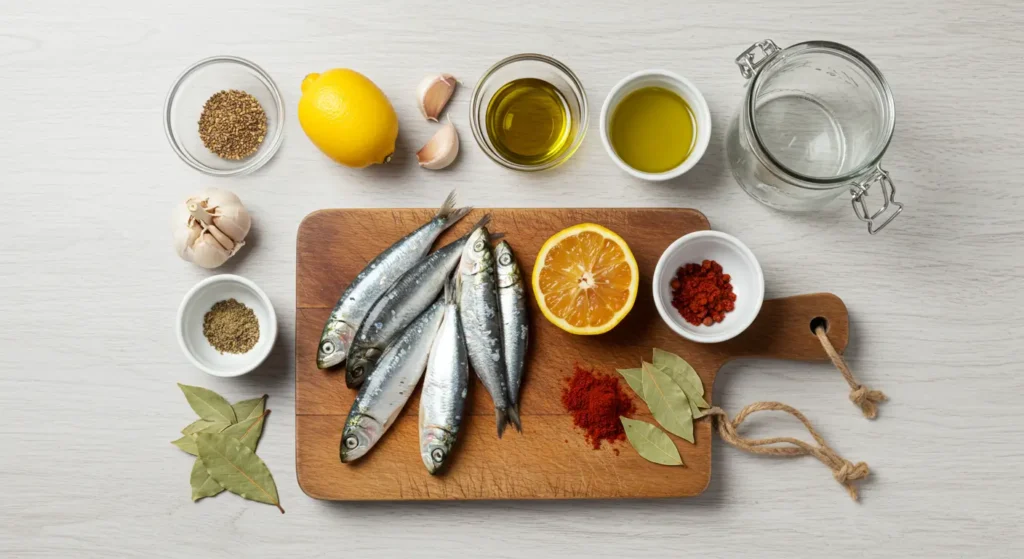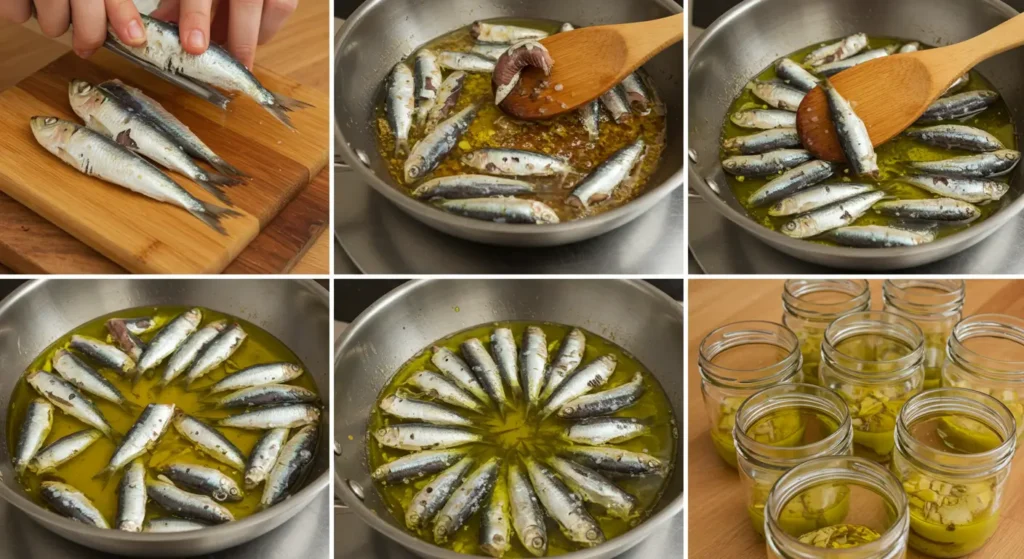Moroccan Sardines In Olive Oil (Authentic Mediterranean Method)
Have you ever opened a jar of Moroccan Sardines In Olive Oil, only to be hit by that wave of warm olive oil, sea salt, and sun-soaked memory?
It’s the kind of scent that instantly pulls you back—to a family kitchen in Asilah, a breezy lunch in Essaouira, or a grandmother quietly layering sardines with lemon and cumin under the July sun.
This is not just another sardine recipe. It’s a Moroccan take rooted in tradition, yet tailored for the modern home cook. No preservatives. No pressure canning. Just pure olive oil, bold spices, and an easy method that honors our coastal heritage.
Whether you’re:
- A seafood lover craving something homemade and preservative-free,
- A nostalgic Moroccan abroad missing the flavors of home,
- Or someone simply curious about Mediterranean flavors with depth—
This Sardines In Olive Oil recipe is crafted for you.
In this complete guide, you’ll learn:
- How to prep fresh sardines the Moroccan way
- The step-by-step oil-poaching technique
- Unique spice blends that transform every bite
- Storage tips and serving suggestions that make it versatile
Ready to taste the sea—Moroccan-style? Let’s dive in.
Table of Contents
Moroccan Sardines In Olive Oil – Recipe Card
Craving the real taste of Sardines In Olive Oil, done the Moroccan way? This easy recipe delivers deep Mediterranean flavor with just a handful of pantry staples. Perfect for preserving or serving fresh.
- Prep Time: 20 minutes
- Cook Time: 45 minutes
- Total Time: 1 hour 5 minutes
- Servings: 4 jars (approximately 4 servings)
- Calories: ~220 per serving
- Cuisine: Moroccan, Mediterranean
- Tags: Gluten-Free, High-Protein, Low-Carb, Preserved Fish

Ingredients for Authentic Sardines In Olive Oil:
- 12 fresh sardines (cleaned and gutted)
- 2 cups Moroccan extra virgin olive oil
- 1 preserved lemon (thinly sliced)
- 4 garlic cloves (smashed)
- 2 bay leaves
- 1 tsp cumin seeds
- 1/2 tsp paprika (optional)
- 1/2 tsp chili flakes (optional)
- Salt to taste
Equipment Needed:
- Wide saucepan or skillet
- Sterilized glass jars with lids
- Slotted spoon
- Fine mesh sieve (optional)
Sardines In Olive Oil Instructions (Step-by-Step Moroccan Way)

Making Sardines In Olive Oil at home isn’t just cooking—it’s preserving memory, heritage, and the coastal essence of Morocco in every bite. Follow these forgiving steps to transform simple ingredients into a powerful traditional preserve.
Step 1: Clean and Prep the Sardines
Rinse the sardines under cold water. Remove the heads, guts, and backbone to yield butterfly fillets (or leave whole if preferred for a rustic feel).
Pro Tip: Soak them briefly in salted water with a splash of vinegar—this tones down the fishiness.
Step 2: Layer Your Flavors
In a wide, shallow pan, add a layer of olive oil.
Distribute garlic, bay leaves, cumin seeds, preserved lemon slices, and chili flakes across the bottom. Lay the sardines skin-side down in a single layer. Sprinkle with salt.
Optional: Add another layer if needed—just make sure oil covers them completely.
Step 3: Slow-Poach the Sardines In Olive Oil
Turn the heat to low and bring the oil to a gentle simmer—never boiling. Cook uncovered for 30–45 minutes until the sardines are soft, aromatic, and infused with Moroccan spice.
You’ll know it’s ready when the flesh separates easily with a fork and the oil smells like a coastal kitchen.
Step 4: Pack & Store
Using a slotted spoon, gently lift the sardines and layer them into sterilized glass jars. Strain and pour the remaining olive oil on top until fully submerged.
Let the Sardines In Olive Oil cool, seal tightly, and refrigerate.
They’ll last up to 10 days in the fridge. For long-term storage, pressure canning is recommended.
Can I use canned sardines instead?
Technically yes, but it’s a shortcut.
Canned sardines are already cooked and lack the delicate spice infusion of true Moroccan-style Sardinas . If you must, heat them briefly in seasoned oil—but the soul will be missing.
Sardines In Olive Oil Substitutions & Creative Variations

Making Sardines In Olive Oil should never feel rigid. Moroccan cuisine thrives on instinct, substitutions, and local improvisation. Whether you’re short on an ingredient or simply want to customize the flavor, here’s how to adapt without compromising tradition.
Ingredient Swaps That Still Feel Moroccan
- No Preserved Lemon?
Use fresh lemon slices + a pinch of sea salt. Add a dash of vinegar to mimic the tang. - Out of Cumin Seeds?
Ground cumin works too. Toast it lightly first to release aroma. - Chili-Free Version
Skip the chili flakes for a kid-friendly or milder taste. A touch of black pepper will still give warmth. - No Fresh Sardines?
Mackerel or anchovy fillets can substitute. Reduce the cooking time slightly—they’re more delicate but still make great Sardines In Olive Oil alternatives.
Vegetarian Twist
Yes, it’s possible. Replace sardines with thick strips of eggplant or oyster mushrooms. Poach them the same way in Moroccan-spiced olive oil. It won’t be traditional, but it will still capture the essence of Sardines In Olive Oil with a plant-based twist.
Add Your Signature
- A few threads of saffron soaked in warm water, added before cooking? Pure luxury.
- A spoonful of argan oil mixed into the olive oil base? Deep nutty flavor, very Moroccan.
Can I make this without olive oil?
Technically yes, but don’t.
The olive oil isn’t just for cooking—it’s the soul of the dish. Without it, you lose that velvet texture and preservation power that makes Sardines In Olive Oil unique. If cost is an issue, blend it with a neutral oil, but never skip it entirely.
Sardines In Olive Oil Health Benefits & Nutritional Info
Sardines In Olive Oil aren’t just a comfort food—they’re a Mediterranean superfood, blending bold flavor with a surprising nutritional punch. From Morocco’s coastlines to your kitchen, these preserved gems offer both depth and wellness in every bite.
What’s Inside Each Bite?
Nutritional breakdown per 100g (approx. 2–3 fillets in oil):
- Calories: ~220 kcal
- Protein: 25g
- Fat: 12g (mostly unsaturated)
- Omega-3s: 1.5g
- Calcium: ~300mg
- Key Nutrients: Vitamin D, B12, Iron, Selenium
Healthline – “Are Sardines Good for You?
Why They’re Good for You
- Heart Health: Omega-3s help regulate inflammation and support circulation
- Bone Strength: Edible bones deliver a strong calcium boost
- Cognitive Boost: B12 and healthy fats sharpen focus
- Mood & Immunity: Thanks to iron and vitamin D
WebMD – “Sardines: Health Benefits, Nutritional Info & Potential Risks
Olive Oil – The Natural Preserver
- Anti-inflammatory and antioxidant powerhouse
- Enhances digestion and nutrient absorption
- Keeps the fish shelf-stable and naturally flavorful
Are Sardines In Olive Oil better than canned tuna?
In most ways, yes.
They’re fresher, lower in mercury, and richer in nutrients. The inclusion of soft bones adds natural calcium. If you’re aiming for flavor, sustainability, and health in one jar—this is your fish.
Verywell Health – Sardines & heart health
Sardines In Olive Oil Moroccan vs Spanish (A Cultural Flavor Clash)
Sardines In Olive Oil might come from the same sea, but how each culture prepares them is wildly different. While Spain embraces industrial canning, Morocco leans on spice, freshness, and the soulful act of home cooking.
Origins and Flavor Philosophy
- Spanish Sardines: Typically preserved in vinegar, tomato, or chili oil—sharp, soft, and acidic.
- Moroccan Sardines: Infused with cumin, garlic, preserved lemon, and olive oil. The taste is richer, the texture firmer, and the overall experience more layered.
Cooking Methods
- Spain: Pressure-cooked or slow-poached for long shelf life.
- Morocco: Poached in spiced oil or grilled over charcoal—favoring boldness over preservation.
The Cultural Experience
- Spanish sardines are often eaten cold, straight from the tin.
- Moroccan sardines are woven into meals: folded into flatbread, served over couscous, or spooned onto warm khobz.
In Morocco, making sardines is more than food—it’s heritage on a plate.
Which version is healthier?
Depends on your priorities.
Spanish varieties may have fewer calories if canned in tomato, but Moroccan-style Sardines In Olive Oil (made fresh, with olive oil and natural spices) offer higher omega-3s, fewer additives, and deeper nutrition.
Author’s suggestions
Conclusion: A Jar Full of Memory, A Bite of Morocco
What you’ve just created isn’t just Sardines In Olive Oil. It’s a jar filled with salt, sun, and story—a Moroccan mosaic of lemon, garlic, cumin, and coastal memory, preserved the way generations before us intended.
In a world chasing flashier meals, going back to something this humble feels grounding. Sardines, when slowly poached in oil, become more than protein. They become presence. Texture. A whisper from the sea—wrapped in spice.
So next time you crave something nourishing yet nostalgic, don’t reach for a tin. Make your own Sardines In Olive Oil with a little time, a clean jar, and a Moroccan heart.
If you tried this recipe—or added your own twist—I’d love to hear about it.
Leave a comment, share a photo, or pass it down to someone who still believes that food connects us more than it feeds us.
Sardines In Olive Oil Frequently Asked Questions (FAQ)
Still curious about how to make, store, or enjoy this traditional Moroccan recipe? These FAQs cover everything from storage tips to serving ideas.
How long can I store Sardines In Olive Oil in the fridge?
If properly sealed and refrigerated, they’ll stay good for up to 10 days. Beyond that, use proper canning methods to ensure safety.
Can I freeze sardines in oil?
You can—but it’s not ideal. The oil may separate or turn cloudy, and the texture of the fish could be compromised. Fresh is always best with this type of preserve.
Are sardines safe to eat with the bones?
Yes. When cooked slowly, the bones become soft and edible. They’re also a rich source of calcium, especially in Moroccan-style preparations.
Do I have to use preserved lemon?
Not necessarily. Fresh lemon with salt and vinegar works too. But preserved lemon adds a complex Moroccan tang that elevates the dish.
Is this recipe good for meal prep?
Definitely. Make a batch on the weekend and enjoy throughout the week—on toast, in salads, wraps, or with couscous. It’s fridge-friendly and high in protein.
Disclaimer: This content is intended for informational purposes only and should not be considered a substitute for professional medical advice, diagnosis, or treatment. Always seek the guidance of a qualified healthcare provider with any questions you may have regarding a medical condition.
Did you make this recipe?
There are no reviews yet. Be the first one to write one.

